Palm oil production is the process of converting palm fruit into the oil widely used in our daily lives. This process involves multiple key stages, including raw material reception and pretreatment, sterilization, threshing, digestion, pressing, oil clarification, vacuum drying, and refining. Now, let's delve into this complex and efficient production process and unveil the mystery behind the birth of palm oil.

Freshly harvested palm fruit bunches must be processed within 48 hours to prevent Free Fatty Acid (FFA) increase, which degrades crude palm oil (CPO) quality. Workers screen bunches to remove impurities (branches, stones) before feeding them whole into sterilization tanks.
Essential for quality, sterilization uses high-temperature, high-pressure steam/hot water to cook bunches. This softens fruit mesocarp for later processing, destroys enzymes (preventing lipase-induced FFA rise) and microorganisms, and loosens fruit-stalk bonds. Sterilized bunches become pliable.
Cooked bunches enter rotating threshers. The loosened fruit-stalk connections allow efficient mechanical separation of individual fruits from the bunch stalk, ensuring fruit integrity for pressing and boosting efficiency.
Separated fruits are conveyed to digesters. Rotating shafts and paddles mash the fruit, breaking down its cellular structure and tissue. This increases mesocarp surface area, liberating oil for efficient extraction during pressing.
The digested mash is fed into presses (typically twin-screw types). Mechanical pressure extracts oil from the mesocarp, forming CPO. The twin-screw design provides dual-stage propulsion and pressing, maximizing oil yield and production economics.

Pressed CPO contains solid impurities (fruit fiber, nut powder). Clarification removes these using settling tanks, centrifuges, and/or filters, significantly improving oil purity for subsequent drying and refining.
Clarified CPO retains moisture harmful for storage. Vacuum dryers heat the oil under vacuum to remove water, preventing oxidation and stabilizing acid value (FFA content) for storage/transport.

To achieve food-grade quality, refining processes CPO through degumming (remove gums), deacidification/neutralization (remove FFAs), bleaching (remove color), and deodorization (remove odors/volatiles). This enhances value and market competitiveness.
Palm oil production is a complex, efficient transformation from raw fruit to refined oil. Each stage is crucial for quality and yield. Huatai Oil Machinery employs the mature pressing process within a self-sufficient model, reducing costs and environmental impact while promoting resource recycling, tailored to source country conditions.
Huatai Oil Machinery provides good quality oil mill plant, time & fast delivery, perfect after-sale services, and reasonable price, contact us!
Website: https://www.huataioilmachine.com/Copyright @ Henan Huatai Cereals And Oils Machinery Co.,Ltd.
Contact us now